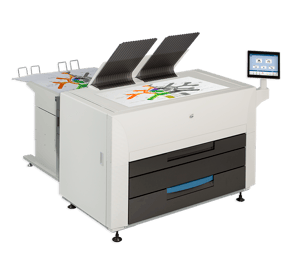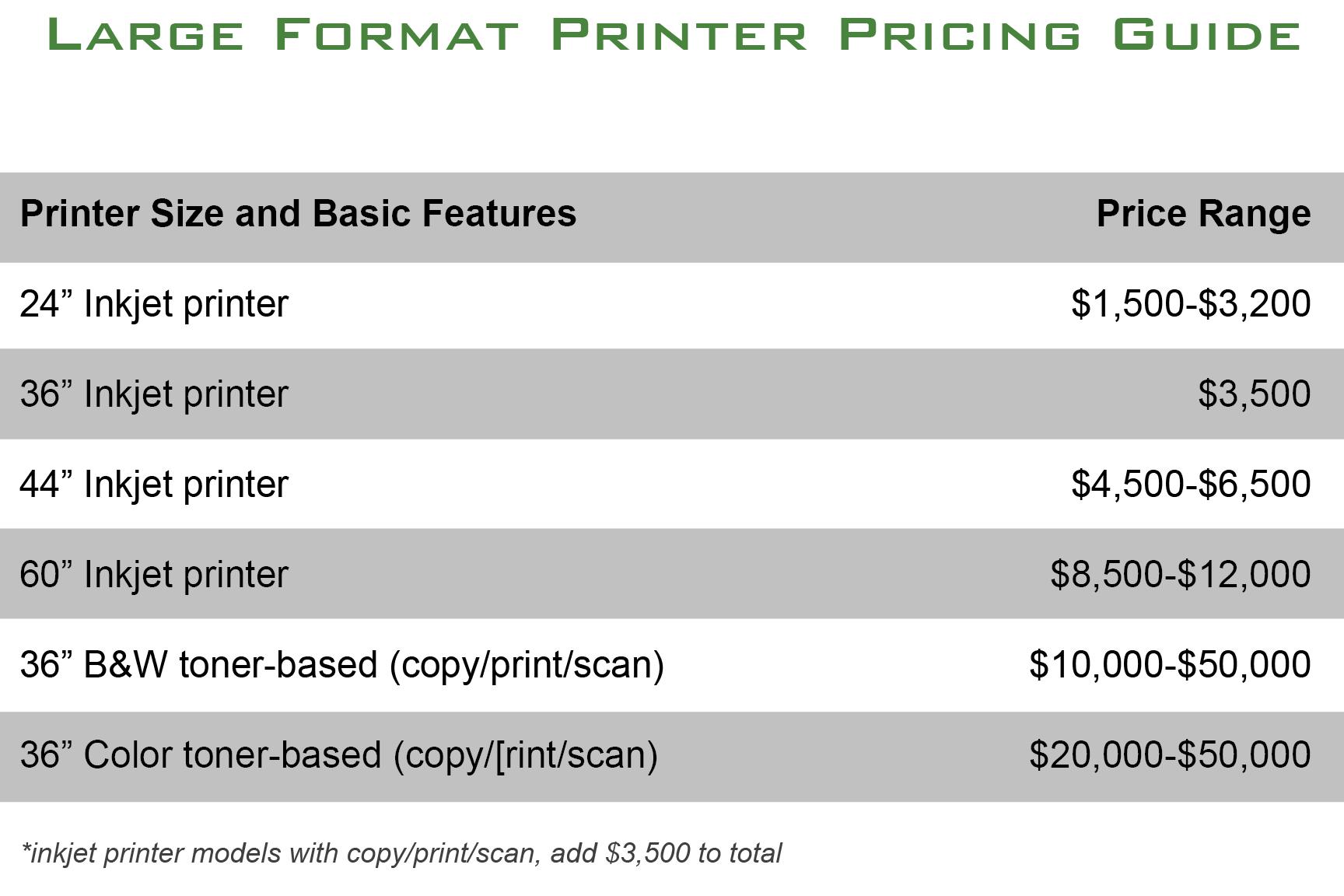
LARGE FORMAT PRINTERS | 6 MIN READ
If you are reading this article, you’ve likely identified a need for a large or wide format printer (aka plotters). The question becomes – “What’s the next step?” More than likely it’s to find out the cost, so you do your research only to find that there is a broad range in large format printers for sale. You may not have the budget to simply purchase the most expensive model (though wouldn’t that be nice?), so how do you make your decision?
This article will help you understand the features included in large and wide format printers as well as the price range. If you are looking for a comparison of some of the best brands, READ: Best Wide Format Printer 2018
Not a lot of time?
Skip to features
Skip to the prices
Differences That Impact Price
Like the purchase of a car, the price of your printer will have similar results depending on the features you choose. Consider a car of the same make, model and year. They should all cost the exact same amount, correct?
Of course not.
Your price could be dramatically different if you get a sunroof, leather interior, power and heated seats, and the deluxe dashboard with navigation system. When compared to the standard model, which doesn’t include any of these features, that seems fair. Wide format printers are similar.
Reliability and durability are also important considerations. Sticking with the car analogy, it wouldn’t make sense to purchase a small convertible if you need a vehicle to pull a tree stump out of the ground or haul equipment. If you can afford it, you also might spring for the vehicle that has better reviews.
After all, a better made vehicle will be cheaper down the road if you’re able to avoid expensive maintenance and repair costs. Likewise, a better made printer that’s of the correct specifications to meet your needs is going to be the best option for you, long term.
Large Format Factors to Consider
 Now that we are on the same page regarding value, let’s talk specifically about what to consider. Volume is often not given the importance it deserves (and I’m not talking about a stereo).
Now that we are on the same page regarding value, let’s talk specifically about what to consider. Volume is often not given the importance it deserves (and I’m not talking about a stereo).
If your system is rated for 3,500 sq. ft. per month, but you intend to run 7,500 sq. ft., it doesn’t mean your system is incapable of completing the job. It just means there will be a loss of productivity because of the increased downtime. Putting a system through more strain than it’s designed to handle is a recipe for problems – and they always seem to happen right at a deadline.
Additionally, the increased volume can reduce the amount of time you are able to keep the system in operation before having to find a replacement. Imagine a lawn care service forgoing the use of commercial lawn mowers for residential models because they are cheaper on the front end. If you are deciding between a higher or lower cost model, consider your volume and ask yourself how much the inevitable downtime could cost you.
Some systems require more operator intervention and assistance. If you are looking to find a printer where you press a “green button” and then walk away until the job is finished, then considerations like the capacity of the output tray are important.
For instance, if most of your jobs are 30-50 pages and you need multiple sets for a client, an inkjet system may not be right for you. Inkjet systems are designed to run small print jobs and don’t have a sophisticated output tray compared to the toner-based systems – but the machines are typically cheaper when compared to a like-sized toner system.
Outsourcing Large Format Printing
Just like an organization’s decision to lease/purchase a copier, look at the jobs you currently outsource and what you anticipate for the future. If you can eliminate the need to outsource and invest a little bit more in a system that has more capabilities, you may find significant cost savings over the life of your printer. In addition to this, you no longer need to consider turnaround or wasted time due to outsourcing.
Inkjet vs Toner Large Format Printers
Before you begin to look at wide format models, you need to consider your volume demands within an ink/toner standpoint. Often, the price of a system is misleading. Besides the cost of equipment, you also need the cost of operation to calculate the total cost of your investment. The most commonly known example of this is with inkjet printers (desktop or wide format).
The printer is at a relative low cost to purchase, but the ink cartridges are very expensive. So, over time you may pay more for the inkjet printer than you would a more expensive toner-based system. This is because the cost of operation for the toner system is much less – often 30 -40% less – than the inkjet system. Inkjet and toner can both be satisfactory options for your needs, but your usage will determine which type is most cost-effective.
Why is this the case?
Inkjet cartridges are not easily reusable due to the way they are constructed. When a cartridge empties, the entire component is often discarded or recycled, even though the majority of its components are still usable. There is a reason why cartridge-based systems are often referred in the industry as "liquid gold."
When a toner-based printer runs out of toner, you simply replace the toner bottle each time, resulting in a much cheaper refill. Depending on your volume, this can be a significant cost savings. For a more detailed breakdown of the cost differences of inkjet and toner-based systems, READ: How Much Does a Copier Cost?
Features to Consider
Most printers now have a plethora of features. The question you must ask is what do you need? Are you looking for the printer with the sunroof, leather seats and voice navigation system (metaphorically speaking, of course), or do you simply need something that will get you from Point A to Point B? Below is a list of some of the most important features to consider that will have an impact on pricing:
- Paper rolls (sizes and how many)
- Ability to run cut-sheet paper
- Specialty media capabilities
- Inkjet vs. toner-based (drawing, posters, and banners will affect this)
- Output for outdoor signage (long or short term)
- Color printing
- Color scanning
- Production or moderate volume scanning needs
- Single file per multi-page scan vs. single file per single page scan
- Cropping to print capabilities
- Output speed
- Volume capabilities (consistent printing throughout the month or all at one time)
- Number of users should also be factored into volume considerations
AEC Industry Specific -
- Software needs to submit batches of PDFs
- Cost recovery/accounting for projects
- Standard output tray or stacker (for large sets of drawings)
- Or does your company run ones and twos?
 So… How Much Does a Large Format Printer Cost?
So… How Much Does a Large Format Printer Cost?
As you can see from the information presented above, the features and considerations for a large or wide format printing system can have a dramatic range. When it comes to price, an equally vast range exists, as can be viewed in the chart on the right.
Most people looking for wide format printers are doing so for business reasons. Each business has unique needs that require unique solutions. By educating yourself, you have taken a great step toward being better equipped with information that is necessary to make the best purchase. As a result, you are much more likely to choose the investment that is most suitable for your company’s budget and needs.
Happy Hunting!
Posted by SOS Can Help
Standard Office Systems prides itself on consistently creating value for its clients with our unparalleled customer service. We not only achieve, but exceed industry standards & client expectations with our true in-house leasing, on-site Network Operations Center (NOC), client response time, and first-call fix-rate in Atlanta, GA and nationally.


